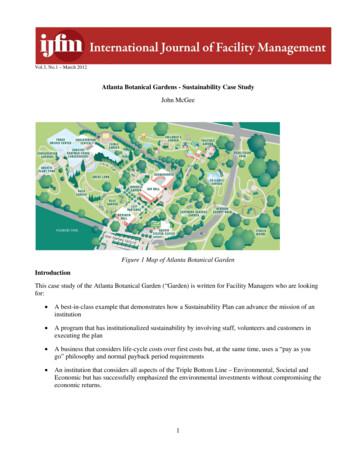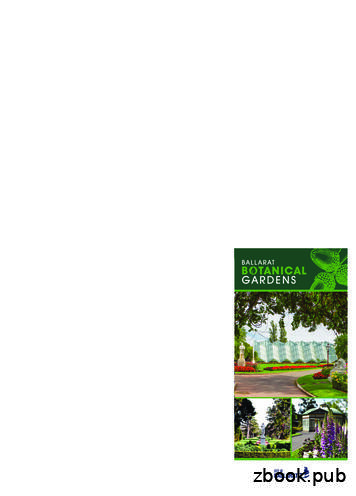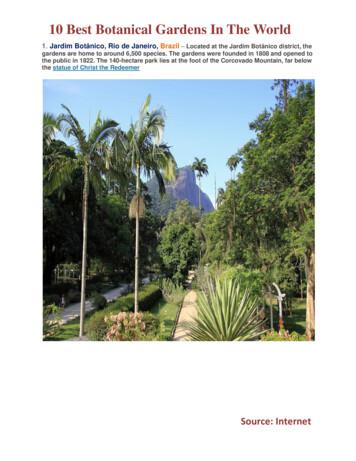Atlanta Botanical Gardens - Sustainability Case Study
Vol.3, No.1 – March 2012Atlanta Botanical Gardens - Sustainability Case StudyJohn McGeeFigure 1 Map of Atlanta Botanical GardenIntroductionThis case study of the Atlanta Botanical Garden (“Garden) is written for Facility Managers who are lookingfor: A best-in-class example that demonstrates how a Sustainability Plan can advance the mission of aninstitution A program that has institutionalized sustainability by involving staff, volunteers and customers inexecuting the plan A business that considers life-cycle costs over first costs but, at the same time, uses a “pay as yougo” philosophy and normal payback period requirements An institution that considers all aspects of the Triple Bottom Line – Environmental, Societal andEconomic but has successfully emphasized the environmental investments without compromising theeconomic returns.1
Figure 2 Atlanta Botanical Garden EntranceThe Atlanta Botanical Garden (“Garden”) is a 30-acre botanical garden in Midtown Atlanta, Georgia.Christy Jellets, Facility Manager, for the Atlanta Botanical Gardens emphasizes that, since 1976, the missionof the gardens has had a consistent focus and that is to: "Develop and maintain plant collections for thepurposes of display, education, conservation, research and enjoyment1”. Consequently, the Garden is both a“Botanical Museum” and a sustainability-learning laboratory.Figure 2View of the Garden with Atlanta in the backgroundTo advance its mission, the Garden’s Board initiated a multi-phase “Green Expansion Plan.” During theconstruction phase the plan emphasized five key areas of human and environmental health: Sustainable site development2
Water savings Energy efficiency Materials selection and Indoor environmental quality.Completed in early-2010, the Green Expansion Plan resulted in a new visitor’s center, the building of greenroofs, the installation of an underground 100,000-gallon water cistern, the construction of a new pedestrianpath, and the planting of a southern seasons garden.Sustainability Attributes Exhibited by the Green Expansion PlanThe Garden’s Green Expansion Plan has a number of exemplary sustainability attributes, including: Strategic Sustainability Performance Plan. The Garden’s Green Expansion Plan placed a strategicemphasis on environmental stewardship. Sustainability learning laboratory: A specific focus of the plan was to advance the entire Gardento be a dynamic, living, learning laboratory for sustainability initiatives. LEED Certification The Garden made a decision to have its new buildings certified in accordancewith the requirements of the LEED (Leadership in Energy and Environmental Design) GreenBuilding Rating System. This system was developed by the U.S. Green Building Council (USGBC)and is based on a variety of categories, including site sustainability, energy, materials, and indoorquality and divides buildings into four categories - basic certification, silver, gold, and platinum. Triple Bottom-Line Accountability With the Green Expansion plan, the Garden addressed all threeaspects of the Triple Bottom Line - Environmental, Societal and Economic - with the followingembedded in the plan:Environmental Environmental stewardship: The plan explicitly promoted environmental stewardship throughthe safeguarding and effective use of energy, water soil and other natural resourcesSustainable site development: There was a formal process to ecologically plan and implementall aspects of the site’s development.Green space: Green space generally refers to any land area covered with vegetationWater conservation: Being a botanical garden, water conservation was particularlyemphasized from both the viewpoint of reducing water usage and also increasing therecycling of waste waterGreen roof - The plan was approved for the Garden to invest in green roofs. Such roofs fallinto two categories - extensive & intensive: A green roof is one that includes vegetation and agrowing medium, planted over a waterproofing membrane. "Extensive" green roofs arevirtually self-sustaining and require minimum maintenance "Intensive" green roofs are laborintensive, requiring irrigation, feeding and other maintenance.Heat island effect: This occurs in developed areas where the elimination of natural land coverresults in an increase in outdoor temperatures. The plan included actions that aimed to offsetany heat island effect by vegetation, the new green roofs, and light colored materials thatreflect heat.3
Indoor environmental quality: All actions within the plan considered the relative health of theair in the affected indoor environments.Natural ventilation: Where possible, natural ventilation was emphasized and used outside airwithout the use of a fan or other mechanical system.Natural daylight: Also, where possible, natural daylight is being used to improve the“botanical garden experience” and to reduce energy usage in its buildings.Recycled/Reuse materials: The plan include a comprehensive and ongoing program tocollect, sort, process, convert and reuse discarded materials. This process is often referred toas “cradle to cradle”Thermal/shade curtains: The plan also approved the placement of thermal/shade curtains. Anenergy curtain or screen is an insulating blanket that adds an additional thermal boundary ingreenhouses.Societal Green education: A huge emphasis of the plan focused on sustainability education for itsmembers. In particular, educational events were designed to demonstrate how naturalecosystems function and how human beings can best interact with them in order to live in asustainable manner.Zero-trash environment: The plan also encouraged the philosophy of redesigningresource life cycles so that all products are reused and to demonstrate how members canimplement similar actions in their home and work environments.Economic Energy Efficiency: Programs and actions were put in place to measuring and analyze energyconsumption so as to improve overall energy efficiency.Green procurement – products & services: An important element of the plan was the drive toprocure environmentally friendly products, services and contractors. This included theembedding of environmental requirements in contracts.Lighting study: Studies were approved with the intent to install more energy efficient lightingand resulting in lower electricity usage.Results from Green Plan ImplementationThe results actions were numerous and each of them impressive: The expansion enhanced the Garden’s plant offerings while reducing the overall heat island2 effectand increased its sustainability features. For example, the new multi-level parking facility, which theGarden shares with neighboring Piedmont Park, occupies only one acre and allows both the Gardenand the park to convert existing parking lots to green space. The plan included constructing newfacilities including the new Hardin Visitor Center and a 600-foot-long Canopy Walk. The installation of three green roofs: one intensive green roof which contains deep soil (as much as18”) that allow for shrubs and perennials to grow and create a garden-like landscape; and twoextensive green roofs which are shallow and provide just enough soil mix for low growing plants likesedum and native grasses. It is worth noting that the extensive roofs are less expensive to build yetprovide most of the benefits of the more intensive design4
Figure 3 Green Roof covering a part of the Hardin Visitor Center A focus on water conservation: a 100,000-gallon capacity cistern was installed underground. Thecistern harvests storm water from a seven-acre watershed and provides irrigation for 40% of the newgardens. A rainfall of 1.2 inches is needed to fill it to capacity. The installation of nineteen foot doors which are open for nine months during the year and allow fornatural ventilation throughout the building and help to claim an energy reduction of 122040 kwh peryear – resulting in a savings of 14,644 in 2010 Recycling granite curbs and reusing materials from the site to preserve the history of the Garden. A minimum damage to trees, critical root zones and tree canopies because non-traditionalconstruction practices were used and resulted in the recycling of removed trees into mulch for use onthe job-site. However, one tree was transformed into a bench that is now on exhibit at the HighMuseum of Art. A new pedestrian path, linking Piedmont Avenue to the Garden and to Piedmont Park, encouragesvisitors and staff to walk or cycle.5
Figure 4 Interior Hardin Visitor CenterLEED Gold - Hardin Visitor Center and SAGE Parking FacilityThe U.S. Green Building Council (USGBC) 3 awarded its LEED Gold certification to two elements of theproject—the SAGE parking facility, built into a steeply sloped hillside, and the Hardin Visitor Center.The Hardin Visitor Center is a visually impressive, transparent structure filled with natural light. It containsthree green roofs that absorb rainfall and provides both sound and thermal insulation. Runoff is eliminated,as the plants absorb rainwater falling on the green roof. The LEED-certified design includes: Natural day lighting Green roof overhead Insulated glass Local and sustainable wood,The plantings that cover nearly 50% of the Hardin Visitor Center roof area provide: Natural cooling, Sound insulation, Additional garden area for visitors, New wildlife habitat.6
Success FactorsFlat Organization StructureA significant percentage of the staff report directly to the Executive Director including the directors andmanagers responsible for marketing, development/institutional advancement, education, human resources,finance, facility operations, conservation and the conservatory. All staff members are encouraged to provideinput and opinions on all major actions being considered.Connecting to Stakeholders - Advancing Members’ Sustainability EffortsThe Garden has an extensive and ongoing program to help its members identify and implement residentialsustainability improvements. Employing a plant hotline, answered daily by volunteers, the Garden answerssuch sustainable questions as “how to build a rain barrel” and “what is the recipe for compost tea?” Withover 300,000 visitors a year, the Garden uses stealth4 learning opportunities to not only share its collectionsof beautiful botanical plants but to educate visitors on how to maintain their own landscapes in anenvironmentally responsible5 way.VolunteersVolunteer participation is critical to the success of the Garden. At present, there are currently over 300volunteers that work alongside the 97 staff. As volunteers continuously meet with visitors (e.g., talking withvisitors during “Breakfast in the Garden”, providing “Discovery Cart” education, etc.), they significantlyimpact the “visitor’s experience.” Consequently, the Garden supports a comprehensive set of programs toorient, train and guide volunteers including initial and ongoing training, support documentation updates,volunteer staff meetings and newsletters.PartnersThe Garden connects with a number of other organizations to ensure the continuance of its mission,including: “Garden To Garden” – a benchmarking initiative with other gardens across the country. Membership of the American Public Gardens Association (APGA6). Recent initiatives include anetwork of Public Garden Facility Managers working on best practices together. Participation on the “Atlanta Cultural Operations Team.” This team is comprised of the operationalleaders for a number of local organizations including the Atlanta History Center, The FernbankMuseum of Natural History, the Atlanta Zoo and the Georgia Aquarium. As a team they share bestpractices and mutually support individual team member initiatives.Fiscal ResponsibilityA comprehensive assessment and due diligence is completed before projects are started that considers lifecycle costs and benefits and expected return on investments. The Garden has a philosophy of “pay-as-yougo” so the Green Expansion Plan was completed in phases at a total cost of 55M. All phases were initiatedafter funds were raised and after a review of costs and projected benefits.Capital PlanningBoard, executives and staff work closely together to plan and execute sustainability projects. The Gardenhas an established consensus-driven culture so staff and volunteers have the ongoing opportunity to impactfuture plans via participation during staff focus groups. “Give us feedback” is an important goal of theGarden.7
Programs and PracticesThe Garden is developing a Green Sustainability Plan with an emphasis on Sustainability practices,including: Capital ProjectsWhen capital projects are undertaken, particular consideration is given to incorporating the ability toimplement future sustainability projects. For example, the SAGE parking facility was constructedusing framing that would accommodate the future deployment of solar panels. Energy Efficiency FocusThe Garden has been active in approving and implementing a variety of Energy Efficiency programs,including: an extensive lighting study, deploying lighting sensors as well as a program to deploysolar panels. While the Garden is not energy self-sufficient yet because of the energy requirements ofthe Conservatory and Orchid Center, it has already implemented energy efficiency initiatives thathave had a major positive impact on the reduction of energy costs.It is noteworthy that Georgia Power has been particularly helpful and generous by providingtechnical advice and energy credits for approved projects.Energy efficiency continues to be a major focus with solar projects being the first priority followedby the implementation of lighting upgrades VisitorsThe Garden requests that visitors take their waste home with them and support the Garden’s effortsto achieve a zero-trash environment. This initiative saved over 7,000 in its first year. Employees.Human Resources Director coaches staff as they plan and execute their environmental stewardshipactions. Relevant Garden initiatives include:o Water conservation through the use of the Garden’s onsite hydro-station. Additionally,employees are encouraged to “bring your own glass” to meetings and other activities. Inkeeping with its focus to support doing the right things for the environment, this programhelps the Garden to avoid using Styrofoam and paper cupso Disposal of all waste via an on-site compactoro Employee access to free monthly electronic waste (e-waste) and battery disposal at theGarden which helps reduce landfill wasteo Employee incentives for the use of alternative transportation including monthly employeerecognition and participation in raffles for gift cards. Since May 2009, participation in theprogram has tripled.8
Events and Green Concerts where only recyclable materials are used.Figure 5 "Grand Oiseau de Feu sur l'Arche"(The Large Bird of Fire on an Arch) - Niki de Saint Phalle Outsourced Serviceso Sustainability is built into Service Level Agreements and is part of the evaluation foremployee performance reviews.o When contracts are renewed, vendors are required to document their sustainable practices andtheir plans to achieve additional improvements. These factors are given considerable weightin awarding contracts. Therefore contracts are not driven solely by cost considerations.o Sustainable practices are incorporated into food preparation, the serving of organic food, theprovision of environmentally friendly beverages, composting and the use of recyclablematerials (e.g. bamboo plates)ConclusionEvery aspect of The Atlanta Botanical Gardens is driven by what the Garden calls “Sustainability in Action”which has, as its goal, the achievement of responsible environmental stewardship as well as the realizationof energy and water conservation.The sustainability achieved encompasses not only the Garden and its interaction with visitors, employeesand vendors, but also in its interaction with the City of Atlanta and with other local and national culturalinstitutions.9
For Facility Manager’s it is an excellent example of how Sustainability can be embedded in an institution’smission, strategy, business model, capital plans and maintenance programs and achieve all three aspects ofthe Triple Bottom Line.Figure 6 Evening View of Atlanta Botanical GardenChristy Jellets is quick to encourage existing members to visit often and new and prospective members totake full advantage of the numerous exhibitions, events and classes. And with a justified pride in what theGreen Expansion Plan has accomplished, quotes from their web site: “The Green Expansion of theGarden continues with a number of spectacular new gardens and amenities for visitors to enjoy. The GreenExpansion: Phase II offers visitors wonderful new features to explore including a delicious Edible Garden, asoaring Canopy Walk, the magnificent Storza Woods, and a sparkling Cascades Garden”.10
Appendix: References and Additional Reading American Public Gardens Association (APGA)http://www.publicgardens.org/ Conserve Georgiahttp://www.conservegeorgia.org/ Georgia Department of Natural Resources – Sustainability Divisionhttp://www.gasustainability.org/ Environmental Protection Agency – Georgiahttp://www.gaepd.org/ EPA – State and Local Climate and Energy partner/index.html EPA – Southeastern States Air Quality t/index.html EPA – State Climate Change Mitigation /activities/index.html Green Roofshttp://en.wikipedia.org/wiki/Green roofReferences1. Botanical Garden website ssion-history)2. “An urban heat island (UHI) is a metropolitan area which is significantly warmer than itssurrounding rural areas.” – Wikipedia (http://en.wikipedia.org/wiki/Heat island).Also refer to the IFMA Foundation How-To Landscaping Guide3. U.S. Green Building Council (USGBC) - http://www.usgbc.org/4. Rochelle Schwartz-Bloom, a Duke University .aspx)5. (http://www.ifmafoundation.org/programs/sustain wp.cfm)6. APGA - http://www.publicgardens.org/11
The Atlanta Botanical Garden ("Garden") is a 30-acre botanical garden in Midtown Atlanta, Georgia. Christy Jellets, Facility Manager, for the Atlanta Botanical Gardens emphasizes that, since 1976, the mission of the gardens has had a consistent focus and that is to: "Develop and maintain plant collections for the
HISTORIC The New York Botanical Gardens AND/OR COMMON The New York Botanical Gardens LOCATION CITY. TOWN -VICINITY OF New York COUNTY Bronx STATE New York PHOTO REFERENCE PHOTO CREDIT NEGATIVE FILED AT The New York Botanical Gardens The New York Botanical Gardens DATE OF PHOTO circa 1962; confirmed 1975 IDENTIFICATION DESCRIBE VIEW. DIRECTION. ETC.
Botanical Gardens and two areas of open parkland now known as the North and South Gardens. The Botanical Gardens Nursery was established in 1859. Plants and seeds were received from the Royal Melbourne and Geelong Botanic Gardens. In the 1860s, the principal tree planting began while in 1888 a maze was built in the North Gardens to the same .
10 Best Botanical Gardens In The World Source: Internet 4. Berlin-Dahlem Botanical Garden and Botanical Museum, Berlin, Germany - Opened to the public in 1910, this botanical garden has an area of 43 hectares and 22,000 plant hespecies. The garden is part of the Free University of Berlin and t Botanical Museum is attached to the garden
Botanical gardens have traditionally been landscapes of learning. Whether through passive or active opportunities, visitors to botanical gardens expect to be presented with new information, new sights and new experiences. When combined with the large scale of botanical gardens, their traditional role as educational landscapes puts them
Botanical Gardens were founded by Governor Macquarie, the RTBG is one of six Royal Botanical Gardens in the world - the others being at Sydney and Melbourne in Australia, Kew and Edinburgh in the United Kingdom and Hamilton in Ontario, Canada. ―The Royal Tasmanian Botanical Gardens (Map 1.1) are one of Tasmania's
Botanical Gardens at Sanibel Sanibel, FL 33957 (239) 472-4119 The Cummer Museum of Art & Gardens-6857 museum.org Fort Myers, FL 33901 (239) 334-7419 Everglades Wonder Gardens 27180 Old 41 Road Bonita Springs, FL 34135 (239) 992-2591 10901 Old Cutler Road (305) 667-1651 www.fairchildgarden.org Flamingo Gardens-2955 The Florida Botanical Gardens
300 Luckie St NW, Atlanta, GA 30313 0.6 Atlanta Airport Marriott Gateway 2020 Conv. Center Concourse Atlanta, GA 30337 10.4 Hyatt House Atlanta/Downtown 431 Marietta Street NW Atlanta, GA 30313 0.8 Atlanta Marriott Buckhead Hotel 3405 Lenox Road NE Atlanta, GA 30326 8.2 SpringHill Suites Atlanta Downtown 239 Ivan Allen Jr. Blvd NW Atlanta, GA .
Contents Chapter 1 Welcome to the AutoCAD Civil 3D Tutorials . . . . . . . . . . . . 1 Getting More Information . . . . . . . . . . . . . . . . . . . . . . . . . 2


















